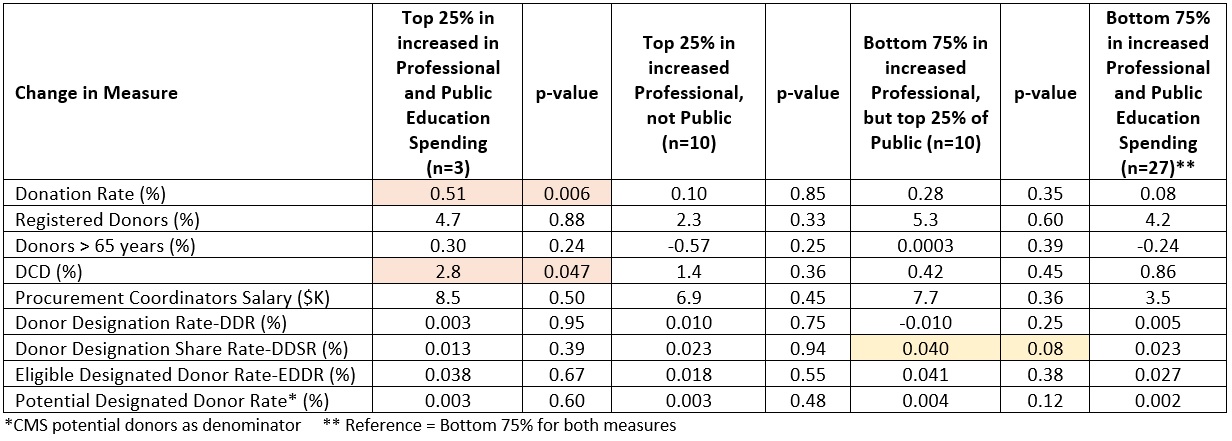Characteristics of OPOs with Increased Education Spending, 2013-2018
1University of California-San Francisco, San Francisco, CA, 2University of Michigan, Ann Arbor, MI, 3University of Florida, Jacksonville, FL, 4Bank of America (former), Walnut Creek, CA
Meeting: 2022 American Transplant Congress
Abstract number: 1335
Keywords: Age factors, Donation, Donors, non-heart-beating
Topic: Clinical Science » Public Policy » 21 - Non-Organ Specific: Public Policy & Allocation
Session Information
Session Name: Non-Organ Specific: Public Policy & Allocation
Session Type: Poster Abstract
Date: Monday, June 6, 2022
Session Time: 7:00pm-8:00pm
 Presentation Time: 7:00pm-8:00pm
Presentation Time: 7:00pm-8:00pm
Location: Hynes Halls C & D
*Purpose: OPO spending on education would be expected to increase donor registration and increase the number of donors. Using data from multiple sources, we examined characteristics of OPOs by change in education spending over six years.
*Methods: OPO cost data was obtained via a Freedom of Information Act request for the 52 independent OPOs for the years 2013 to 2018 (Form CMS-216-94; n=289 OPO-years). Donation rates were calculated using the new CMS metric, employing the CDC’s Detailed Multiple Cause of Death (MCOD) data. Metrics on state-level registration rates were obtained from the Donate Life America’s yearly reports. Within each OPO linear regression was used to estimate the change in spending for both professional and public education, as well the change in other characteristics of the OPOs [donation rate, % registered donors, donors > 65 years, donation after cardiac death (DCD), procurement coordinator salary, and donation metrics]. We classified the OPOs into four groups based on their change in spending, by splitting each type of education spending into two groups (top 25% and bottom 75%). Linear regression was used to estimate differences in the four groups using the OPOs in the bottom 75% of both education groups and the reference and regressing them on each outcome.
*Results: Overall spending by the OPO’s on education increased on average $325k over the 6 years of the study. Increases varied by type of education spending (professional vs. public). OPO’s in the top 25th percentile of change in education spending also increased their CMS donation rate by 0.51 percentage points, which was significantly different compared to OPO’s in the bottom 75% of both types of education spending. This group also had a significant increase in the use of DCD donors (2.5 percentage points). While OPO’s in the top 25th percentile of public education spending (but not professional) had greater increases in the Donor Designation Share Rate (percent of adult population registered to donate), it was only marginally significant.
*Conclusions: Our data show that the OPOs in the top 25% of change in education spending had a significantly greater increase in their CMS donation rate. They also had a larger increase in the use of DCD donors, suggesting this could be one mechanism for increasing donors. We found a marginal association between the top spending OPO’s in public education and percentage of registered donors. Future work will focus on investigating the association between registration rates and donation rates.
To cite this abstract in AMA style:
Roberts J, Bragg-Gresham JL, Peters T, McCormick F. Characteristics of OPOs with Increased Education Spending, 2013-2018 [abstract]. Am J Transplant. 2022; 22 (suppl 3). https://atcmeetingabstracts.com/abstract/characteristics-of-opos-with-increased-education-spending-2013-2018/. Accessed July 18, 2025.« Back to 2022 American Transplant Congress

